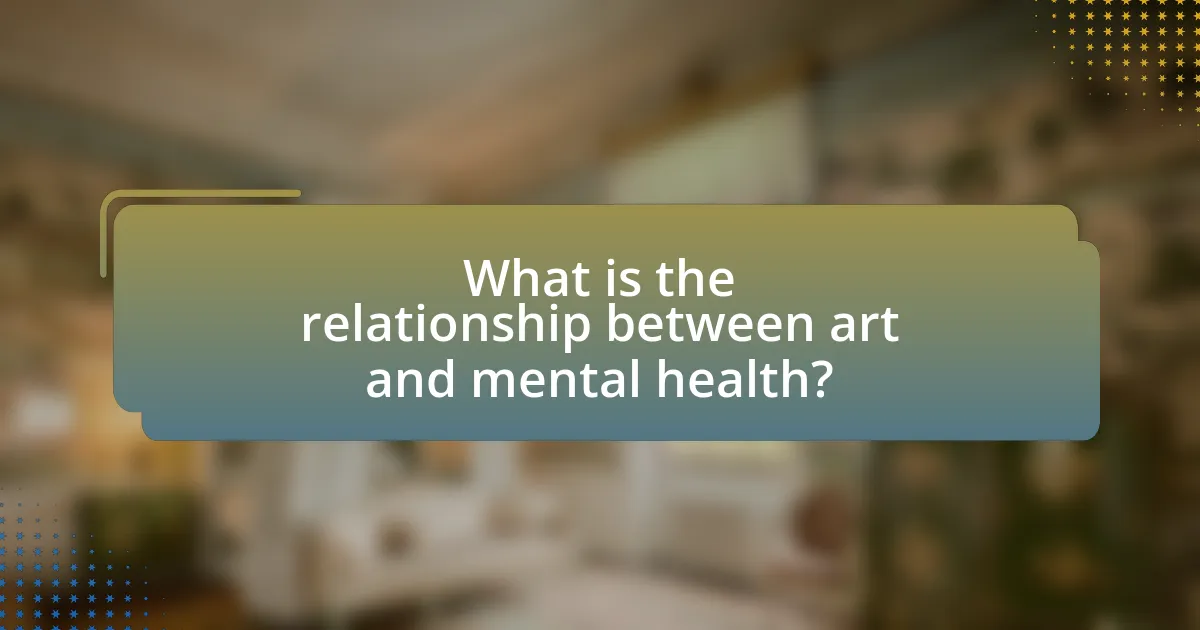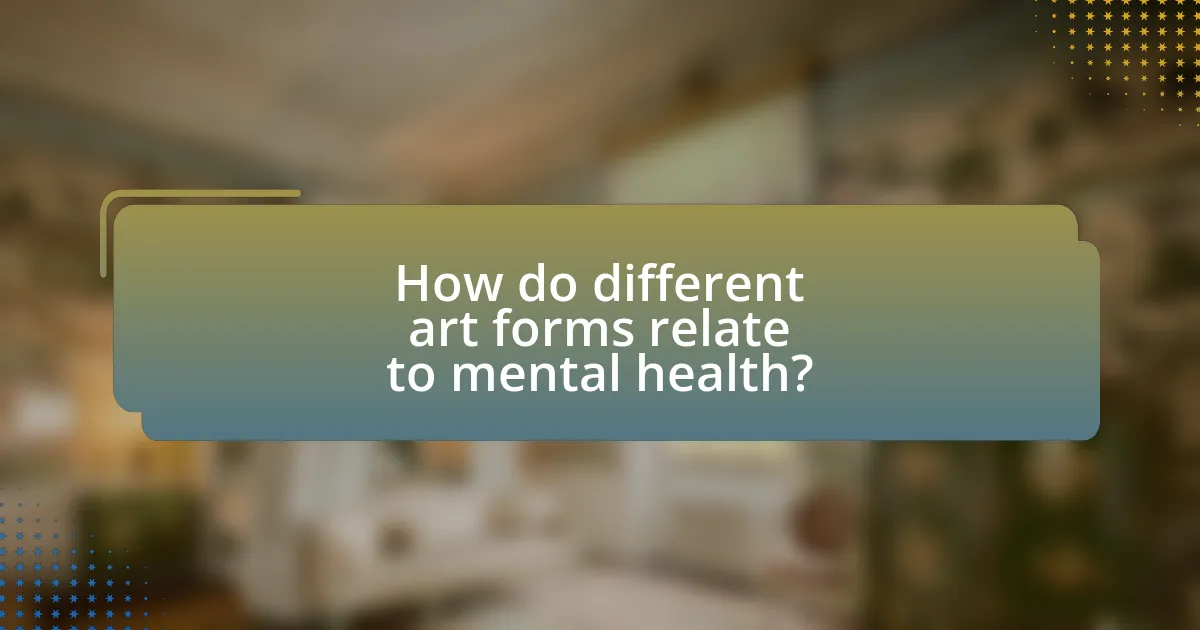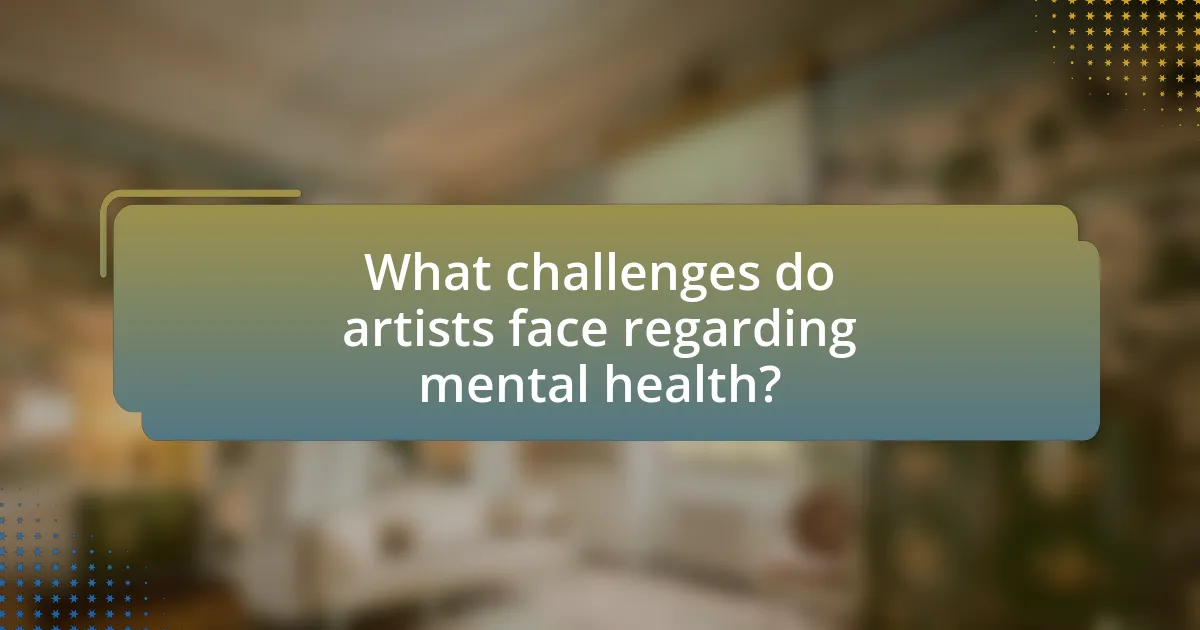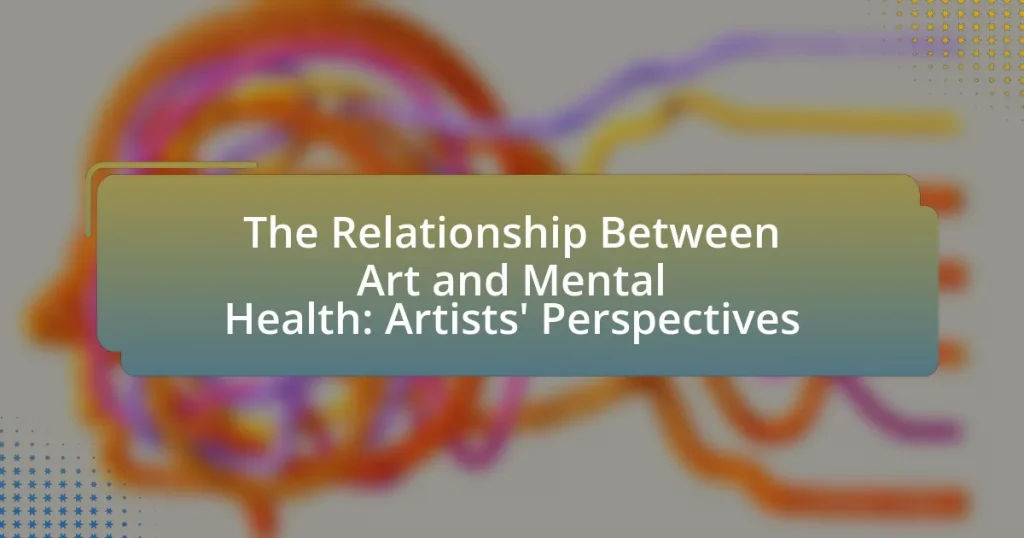The article examines the relationship between art and mental health, focusing on how artistic expression can serve as a therapeutic tool for individuals facing mental health challenges. It highlights the psychological mechanisms through which art influences mental well-being, including emotional expression, cognitive processing, and social connection. The article also discusses the unique benefits of various art forms, such as visual arts, performing arts, and literature, in promoting emotional healing and resilience. Additionally, it addresses the challenges artists face regarding mental health, the impact of industry pressures, and the importance of support networks and coping strategies for maintaining mental well-being.

What is the relationship between art and mental health?
Art significantly influences mental health by providing a means of expression and emotional release. Engaging in artistic activities can reduce symptoms of anxiety and depression, as evidenced by studies showing that art therapy improves psychological well-being. For instance, a study published in the Journal of the American Art Therapy Association found that participants who engaged in art-making reported lower levels of stress and improved mood. This relationship underscores the therapeutic potential of art in enhancing mental health and fostering emotional resilience.
How does art influence mental health?
Art significantly influences mental health by providing emotional expression, reducing stress, and enhancing overall well-being. Engaging in artistic activities, such as painting or music, allows individuals to process emotions and experiences, which can lead to improved mental clarity and emotional release. Research published in the Journal of Positive Psychology indicates that creative activities can decrease anxiety and depression levels, highlighting the therapeutic benefits of art. Furthermore, a study by the American Journal of Public Health found that participation in arts programs can lead to increased life satisfaction and social connectedness, reinforcing the positive impact of art on mental health.
What psychological mechanisms are involved in art’s impact on mental health?
Art impacts mental health through several psychological mechanisms, including emotional expression, cognitive processing, and social connection. Emotional expression allows individuals to convey feelings that may be difficult to articulate verbally, facilitating catharsis and reducing anxiety. Cognitive processing involves engaging with art to reflect on personal experiences, which can lead to insights and improved emotional regulation. Social connection is fostered through shared artistic experiences, promoting a sense of belonging and reducing feelings of isolation. Research indicates that engaging in creative activities can lower levels of cortisol, a stress hormone, and enhance overall well-being, supporting the effectiveness of these mechanisms in improving mental health.
How can art serve as a form of therapy?
Art serves as a form of therapy by providing individuals a means to express emotions, process experiences, and enhance mental well-being. Engaging in artistic activities, such as painting or music, allows individuals to communicate feelings that may be difficult to articulate verbally, facilitating emotional release and self-discovery. Research indicates that art therapy can reduce symptoms of anxiety and depression; for instance, a study published in the Journal of the American Art Therapy Association found that participants experienced significant reductions in anxiety levels after engaging in art-making activities. This evidence supports the effectiveness of art as a therapeutic tool, demonstrating its capacity to foster healing and personal growth.
Why is understanding this relationship important?
Understanding the relationship between art and mental health is important because it highlights how creative expression can serve as a therapeutic tool for individuals experiencing mental health challenges. Research indicates that engaging in artistic activities can reduce symptoms of anxiety and depression, as evidenced by a study published in the Journal of the American Art Therapy Association, which found that 75% of participants reported decreased levels of stress after engaging in art-making. This relationship also fosters greater awareness of mental health issues within society, promoting empathy and reducing stigma associated with mental illness.
What are the societal implications of art and mental health awareness?
Art and mental health awareness significantly influence societal perceptions and behaviors regarding mental health. By integrating art into mental health discussions, communities can foster empathy, reduce stigma, and promote understanding of mental health issues. For instance, studies show that art therapy can improve emotional expression and coping mechanisms, leading to better mental health outcomes. Furthermore, public art initiatives and exhibitions focused on mental health have been shown to engage audiences, encouraging open conversations and increasing awareness. This societal shift not only supports individuals struggling with mental health but also cultivates a more compassionate and informed community.
How can this understanding benefit artists and mental health professionals?
Understanding the relationship between art and mental health can significantly benefit artists and mental health professionals by providing insights into the therapeutic potential of creative expression. For artists, this understanding can enhance their ability to convey emotions and experiences, fostering deeper connections with their audience and promoting personal healing. Research indicates that engaging in artistic activities can reduce symptoms of anxiety and depression, as evidenced by a study published in the Journal of the American Art Therapy Association, which found that 75% of participants reported improved mood after art-making sessions.
For mental health professionals, this understanding can inform therapeutic practices by integrating art as a tool for expression and communication in therapy. Studies, such as those conducted by the American Psychological Association, show that art therapy can lead to significant improvements in emotional well-being and coping strategies among clients. By recognizing the value of art in mental health, professionals can create more holistic treatment plans that leverage the benefits of creative expression, ultimately enhancing patient outcomes.
What perspectives do artists have on their mental health?
Artists often view their mental health as both a source of inspiration and a challenge to navigate. Many express that their emotional struggles fuel their creativity, allowing them to produce profound and impactful work. For instance, a study published in the Journal of Affective Disorders found that artists are more likely to experience mood disorders, which can enhance their artistic expression. Additionally, artists frequently report that creating art serves as a therapeutic outlet, helping them process their emotions and experiences. This dual perspective highlights the complex relationship between mental health and artistic expression, where mental health issues can both hinder and enhance the creative process.
How do artists express their mental health struggles through their work?
Artists express their mental health struggles through their work by using various mediums to convey emotions, experiences, and narratives related to their psychological states. For instance, visual artists often utilize color, form, and texture to depict feelings of anxiety, depression, or trauma, creating pieces that resonate with viewers on an emotional level. Musicians may write lyrics that articulate their internal battles, providing a cathartic outlet for their struggles while also fostering connection with listeners who share similar experiences. Research indicates that art can serve as a therapeutic tool, allowing artists to process their emotions and communicate complex mental health issues, as seen in studies like “The Healing Power of Art” published in the Journal of the American Art Therapy Association, which highlights how creative expression can facilitate emotional healing and understanding.
What common themes emerge in artists’ narratives about mental health?
Common themes in artists’ narratives about mental health include vulnerability, the struggle for self-acceptance, and the therapeutic nature of creativity. Artists often express vulnerability by sharing personal experiences with mental health challenges, which fosters connection and empathy among audiences. The struggle for self-acceptance is frequently depicted, highlighting the internal battles artists face regarding their identities and mental well-being. Additionally, many artists emphasize the therapeutic benefits of creating art, illustrating how the process serves as a coping mechanism and a means of processing emotions. These themes are supported by various studies, such as the 2016 research published in the Journal of Affective Disorders, which found that engaging in artistic activities can significantly reduce symptoms of anxiety and depression.

How do different art forms relate to mental health?
Different art forms significantly impact mental health by providing therapeutic benefits, enhancing emotional expression, and fostering community connections. Visual arts, music, dance, and literature serve as outlets for individuals to process emotions, reduce anxiety, and improve overall well-being. For instance, a study published in the Journal of Positive Psychology found that engaging in creative activities can lead to increased happiness and reduced symptoms of depression. Additionally, art therapy has been shown to help individuals with PTSD and anxiety disorders by facilitating emotional release and self-exploration. Thus, the relationship between various art forms and mental health is well-documented, highlighting their role in promoting psychological resilience and emotional healing.
What are the unique benefits of visual arts for mental health?
Visual arts provide unique benefits for mental health by enhancing emotional expression, reducing anxiety, and improving overall well-being. Engaging in visual arts allows individuals to express feelings that may be difficult to articulate verbally, facilitating emotional release and processing. Studies have shown that art therapy can significantly lower anxiety levels; for instance, a study published in the Journal of the American Art Therapy Association found that participants experienced a 75% reduction in anxiety after engaging in art-making activities. Additionally, creating visual art can foster a sense of accomplishment and boost self-esteem, contributing to improved mental health outcomes.
How does painting or drawing facilitate emotional expression?
Painting and drawing facilitate emotional expression by providing a non-verbal outlet for individuals to convey their feelings and experiences. This form of artistic expression allows people to translate complex emotions into visual forms, enabling them to process and communicate feelings that may be difficult to articulate verbally. Research indicates that engaging in creative activities like painting can lead to reduced anxiety and improved mood, as evidenced by a study published in the Journal of the American Art Therapy Association, which found that art-making significantly decreased levels of cortisol, a stress hormone, in participants. Thus, painting and drawing serve as effective tools for emotional expression and mental health improvement.
What role does sculpture play in mental health recovery?
Sculpture plays a significant role in mental health recovery by providing a tangible medium for expression and emotional processing. Engaging in sculptural activities allows individuals to externalize their feelings, which can facilitate healing and self-discovery. Research indicates that art therapy, including sculpture, can reduce symptoms of anxiety and depression, as evidenced by a study published in the Journal of the American Art Therapy Association, which found that participants reported improved mood and emotional well-being after engaging in sculptural practices. This therapeutic process not only fosters creativity but also enhances self-esteem and promotes social interaction, further supporting mental health recovery.
How does performing arts contribute to mental well-being?
Performing arts contribute to mental well-being by providing a creative outlet for self-expression, which can alleviate stress and anxiety. Engaging in activities such as acting, dancing, or music-making allows individuals to process emotions and experiences, fostering a sense of connection and community. Research indicates that participation in performing arts can lead to improved mood and reduced symptoms of depression; for instance, a study published in the Journal of Positive Psychology found that individuals involved in creative activities reported higher levels of happiness and life satisfaction. Additionally, performing arts can enhance cognitive function and emotional resilience, further supporting mental health.
What therapeutic effects does music have on mental health?
Music has significant therapeutic effects on mental health, including reducing symptoms of anxiety and depression. Research indicates that listening to music can stimulate the release of dopamine, a neurotransmitter associated with pleasure and reward, which can enhance mood and alleviate feelings of sadness. A study published in the Journal of Music Therapy found that music interventions significantly decreased anxiety levels in patients undergoing surgery, demonstrating its effectiveness in clinical settings. Additionally, engaging in music-making activities has been shown to improve emotional expression and social connection, further contributing to overall mental well-being.
How can dance be a medium for healing and self-discovery?
Dance serves as a medium for healing and self-discovery by facilitating emotional expression and promoting physical well-being. Engaging in dance allows individuals to release pent-up emotions, which can lead to reduced anxiety and improved mood. Research indicates that dance therapy can significantly lower symptoms of depression and PTSD, as evidenced by a study published in the Journal of Dance Therapy, which found that participants experienced enhanced emotional regulation and self-awareness after dance sessions. Additionally, the physical activity involved in dance releases endorphins, contributing to overall mental health improvement. Thus, through its combination of emotional expression and physical engagement, dance effectively fosters healing and self-discovery.
What is the impact of literature on mental health?
Literature positively impacts mental health by providing emotional relief, fostering empathy, and enhancing self-reflection. Engaging with literary works allows individuals to explore complex emotions and experiences, which can lead to improved emotional regulation and reduced feelings of isolation. Research indicates that reading fiction, for instance, can enhance empathy by allowing readers to understand diverse perspectives, as shown in a study published in the journal “Science” by David Comer Kidd and Emanuele Castano, which found that reading literary fiction improves theory of mind. Additionally, literature can serve as a therapeutic tool, with bibliotherapy being recognized for its effectiveness in treating various mental health issues, including depression and anxiety.
How does writing serve as a coping mechanism for artists?
Writing serves as a coping mechanism for artists by providing an outlet for emotional expression and processing experiences. Through writing, artists can articulate their thoughts and feelings, which helps them to confront and understand their mental health challenges. Research indicates that expressive writing can lead to reduced anxiety and depression, as it allows individuals to organize their emotions and gain clarity. A study published in the Journal of Clinical Psychology found that participants who engaged in expressive writing reported significant improvements in psychological well-being, demonstrating the therapeutic benefits of this practice for artists.
What role does poetry play in expressing mental health experiences?
Poetry serves as a powerful medium for expressing mental health experiences by allowing individuals to articulate complex emotions and thoughts that may be difficult to convey through conventional language. This form of artistic expression can provide a sense of catharsis, enabling writers to process their feelings and experiences related to mental health challenges. Research indicates that engaging with poetry can enhance emotional awareness and foster a sense of connection among individuals facing similar struggles, as evidenced by studies showing that expressive writing, including poetry, can lead to improved psychological well-being. For instance, a study published in the Journal of Poetry Therapy found that participants who wrote poetry about their mental health reported reduced symptoms of anxiety and depression, highlighting poetry’s therapeutic potential.

What challenges do artists face regarding mental health?
Artists face significant challenges regarding mental health, including high levels of anxiety, depression, and social isolation. Research indicates that artists are more likely to experience mental health issues compared to the general population, with studies showing that approximately 70% of artists report experiencing anxiety and depression. The pressure to create, financial instability, and the often solitary nature of artistic work contribute to these mental health challenges. Additionally, the stigma surrounding mental health can prevent artists from seeking help, exacerbating their struggles.
How does the creative process affect artists’ mental health?
The creative process significantly impacts artists’ mental health by serving as both a therapeutic outlet and a source of stress. Engaging in creative activities can enhance emotional well-being, reduce anxiety, and foster a sense of accomplishment, as evidenced by studies showing that art therapy can lead to decreased symptoms of depression and anxiety in participants. Conversely, the pressure to produce and the fear of criticism can exacerbate mental health issues, leading to feelings of inadequacy and burnout. Research published in the Journal of Affective Disorders indicates that artists often experience higher rates of mood disorders, suggesting that while creativity can be healing, it can also contribute to mental health challenges when coupled with external pressures.
What pressures do artists encounter in the industry?
Artists encounter significant pressures in the industry, including financial instability, high competition, and the demand for constant innovation. Financial instability arises from unpredictable income streams, as many artists rely on freelance work or sales of their art, which can fluctuate greatly. High competition is prevalent due to the large number of artists vying for limited opportunities, making it challenging to gain recognition and secure exhibitions or sales. Additionally, the demand for constant innovation places pressure on artists to continually produce new and original work, which can lead to creative burnout and mental health challenges. These pressures are well-documented, with studies indicating that artists often experience higher rates of anxiety and depression compared to the general population, highlighting the impact of these industry pressures on their mental health.
How can self-doubt and criticism impact an artist’s mental state?
Self-doubt and criticism can significantly undermine an artist’s mental state by fostering feelings of inadequacy and anxiety. When artists experience self-doubt, they often question their abilities and the value of their work, which can lead to decreased motivation and creativity. Research indicates that high levels of self-criticism correlate with increased rates of depression and anxiety among artists, as noted in a study published in the Journal of Affective Disorders by authors such as K. M. Keng and J. M. Keng. Furthermore, external criticism can exacerbate these feelings, as negative feedback may reinforce an artist’s insecurities, leading to a cycle of self-doubt and emotional distress. This interplay between self-doubt and criticism can ultimately hinder an artist’s overall well-being and creative output.
What resources are available for artists struggling with mental health?
Artists struggling with mental health can access various resources, including mental health hotlines, therapy services, and support groups specifically tailored for creatives. Organizations like the National Alliance on Mental Illness (NAMI) provide educational resources and support networks, while the Artist’s Health Alliance offers programs focused on the unique challenges faced by artists. Additionally, online platforms such as BetterHelp and Talkspace provide accessible therapy options. Research indicates that creative expression can serve as a therapeutic outlet, reinforcing the importance of these resources in promoting mental well-being among artists.
How can art organizations support artists’ mental health needs?
Art organizations can support artists’ mental health needs by providing access to mental health resources, creating supportive community environments, and offering workshops focused on mental well-being. Access to mental health resources, such as counseling services or partnerships with mental health professionals, enables artists to seek help when needed. Creating supportive community environments fosters connections among artists, reducing feelings of isolation, which is crucial since studies indicate that artists often experience higher rates of mental health issues. Workshops focused on mental well-being can equip artists with coping strategies and resilience skills, further promoting their mental health.
What role do peer support networks play in artists’ mental health?
Peer support networks significantly enhance artists’ mental health by providing emotional support, reducing feelings of isolation, and fostering a sense of community. These networks allow artists to share experiences, coping strategies, and resources, which can lead to improved mental well-being. Research indicates that social support is linked to lower levels of anxiety and depression among creative individuals, highlighting the importance of these networks in mitigating mental health challenges. For instance, a study published in the Journal of Affective Disorders found that individuals with strong social support systems reported better mental health outcomes, emphasizing the critical role peer networks play in the artistic community.
What practical strategies can artists use to maintain mental well-being?
Artists can maintain mental well-being by establishing a structured routine, engaging in regular physical activity, and practicing mindfulness techniques. A structured routine helps artists create a sense of stability and predictability, which can reduce anxiety and enhance focus. Regular physical activity, such as walking or yoga, has been shown to release endorphins, improving mood and reducing stress levels. Mindfulness techniques, including meditation and deep-breathing exercises, can help artists manage negative thoughts and emotions, fostering a greater sense of calm and clarity. Research indicates that these strategies can significantly enhance mental health, as evidenced by studies showing that physical exercise can reduce symptoms of depression and anxiety by up to 30%.
How can mindfulness and self-care practices benefit artists?
Mindfulness and self-care practices benefit artists by enhancing their mental well-being and fostering creativity. Engaging in mindfulness helps artists reduce stress and anxiety, which can otherwise hinder their creative processes. Research indicates that mindfulness practices, such as meditation, can lead to increased focus and improved emotional regulation, allowing artists to connect more deeply with their work. A study published in the Journal of Positive Psychology found that individuals who practiced mindfulness reported higher levels of creativity and problem-solving skills. Additionally, self-care routines, including regular breaks and physical activity, contribute to better overall health, enabling artists to sustain their creative output over time.
What are effective coping strategies for managing stress in the creative field?
Effective coping strategies for managing stress in the creative field include establishing a structured routine, practicing mindfulness, and engaging in physical activity. A structured routine helps artists allocate specific times for creative work and breaks, reducing overwhelm. Mindfulness practices, such as meditation or deep breathing exercises, have been shown to lower stress levels and enhance focus, as supported by research from the American Psychological Association, which indicates that mindfulness can improve emotional regulation. Additionally, regular physical activity is linked to reduced anxiety and improved mood, as evidenced by a study published in the Journal of Clinical Psychiatry, which found that exercise can significantly alleviate symptoms of stress and depression.















